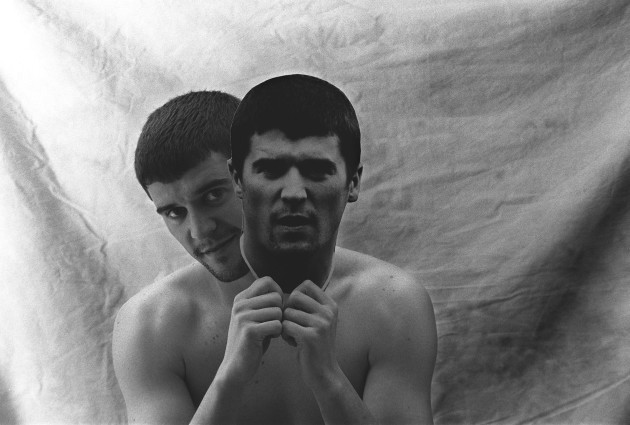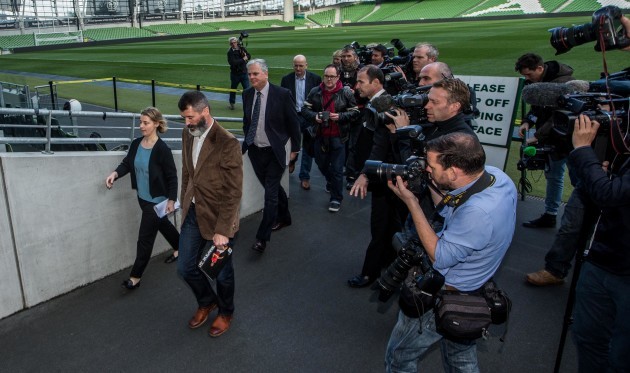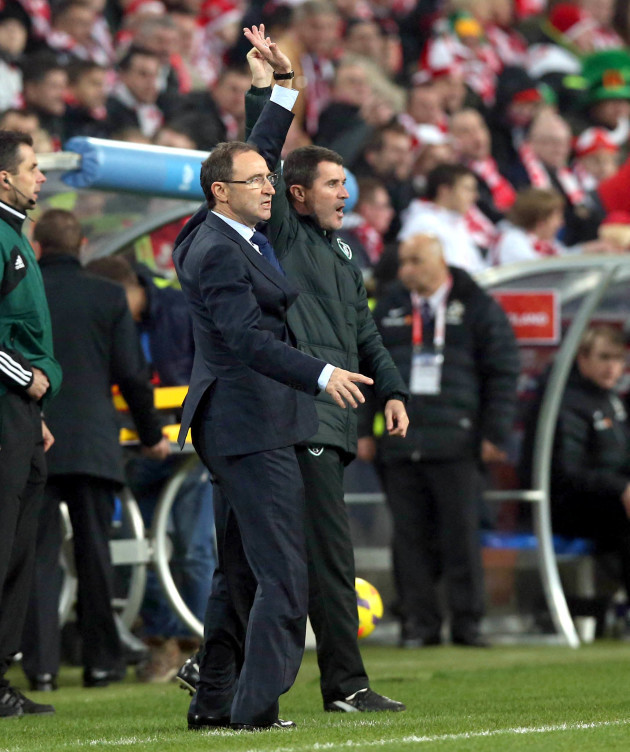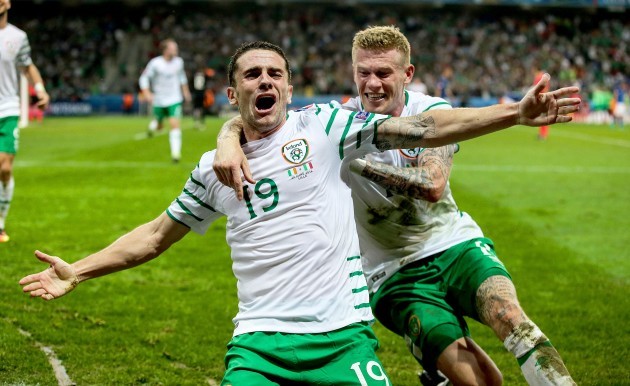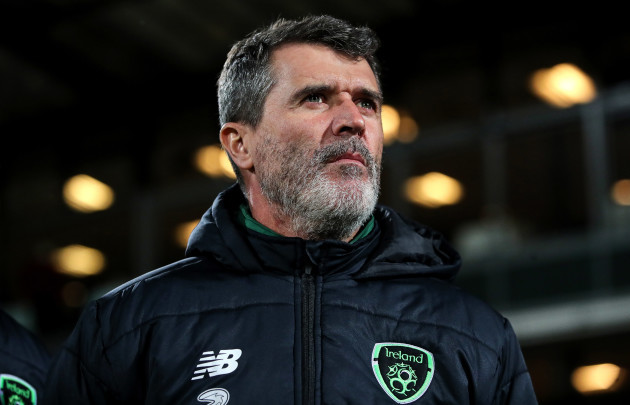For 30 years, the magnificent and controversial Roy Keane has dominated the sporting landscape. In this final chapter of his series on Irish football, Garry Doyle profiles one of Ireland’s most fascinating characters.
IT WAS CLOSING in on midnight when the phone buzzed. Text messages at that stage of the evening often have an importance attached to them and sure enough, the sender was expressing concern. “You read this book?” the message sender asked. “Did I get kicked?”
He didn’t. If anything he got off lightly. Yet the fact a former player, long retired, was worried about Roy Keane’s opinion was a statement in itself.
As a pundit, he hits hard, but so do Graeme Souness, Jamie Carragher and Eamon Dunphy and yet their book launches didn’t result in eight successive days of back page headlines. The former player is a tough man, mentally as well as physically. Yet here he was, fidgeting with his phone, nervous about the content of Keane’s memoirs.
Others were fascinated, to the extent that just over 100 journalists turned up at the Aviva Stadium on an autumnal afternoon for the launch of Roy Maurice Keane’s second autobiography. “What’s it like up there?” one female reporter asked another as she waited for the lift to take her to the press conference. “A load of men getting excited,” was the reply. And yet when Keane entered the room, the chatter immediately stopped, like a classroom scene when a stern teacher returns from break.
The female journalist, previously sceptical, was instantly intrigued, sitting upright at the back of the room to catch a view of a man who had his hair cut especially for the occasion but who had allowed his Downton Abbey-style beard to stay. Much of what he said was rehearsed. “Ferguson had statues built for him, stands named after him …….” He was out for revenge.
And yet a softness was also visible. A lady nervously asked him a question about the people who had guided him through troubled times and Keane’s answer wasn’t just respectful but also candid. “The amount of women who have asked me about him is extraordinary,” his ghostwriter, Roddy Doyle, later says. “He has that effect on them.”
The truth is Keane has an effect on most people, regardless of their sex. When he talks, the nation stops and for three-and-a-half hours on that October 2014 afternoon, as he toured around the empty corporate rooms of the Aviva Stadium for one interview after another, an entourage could be seen walking after him. You joined the tail end of it not just to observe Roy Keane but, more interestingly, the way others acted around him.
For the most part he was polite, once chastising a reporter for asking ‘a stupid question’. When he was later pulled to task on this, he lightened up. “But it was a stupid question,” he smiled. “Where is he?” Then, looking around to see the inquisitor, he widened his smile and said: “And you know it was stupid, don’t you? You weren’t offended, were you?” Keane paused, allowing the journalist to answer, before joking. “I was only trying to help you do a better job.”
Then he stood up again. Another room, another interview. It was 3:45 in the afternoon. The vast majority of the stadium was empty and the only sounds came from the muffled whispers of reporters’ tape recordings as Keane’s words got transcribed.
Most were wearing their Sunday best. “Is everything okay? Were you at a funeral beforehand or something?” Neil O’Riordan, from the Irish Sun asks your correspondent after noticing that he, for once, had ironed his shirt.
Keane, too, was sharply dressed. His hair had flecks of grey in it and the beard, which he shaved off a day later, caused as much discussion that week as his views on Ferguson and the Class of 92.
His face, once haunted and angry, appeared more relaxed. However, when he spoke with Kevin Kilbane, a former colleague and now a pundit with the BBC, it varied wildly.
A long time ago, just after Saipan, he and Kilbane had a run-in during the game between Manchester United and Sunderland. Early in the match, they went in for a 50/50 challenge and Keane caught Kilbane with his trailing leg, leaving a bruise which lasted for weeks. Within minutes, Kilbane got him back and if Keane felt the force of Kilbane’s studs then Kilbane would soon experience the strength of the Cork-man’s tongue. “Where’s your pal now? Where’s Niall Quinn now?” Keane taunted him.
If there was tension then, it had long since disappeared. He spoke fondly of Kilbane in his book and his face lit up when he saw him again here. Yet, they had a schedule to stick to, and immediately got down to business. Initial friendliness turned frosty, though, when Kilbane’s line of questioning turned to Saipan, a wound that has never healed.
Yet even as his eyes narrowed and a piercing glare was delivered, once the interview ended, it was all forgotten. He briefly joked with his one-time midfield partner, signed two copies of the book for him and wished him well. Later a BBC cameraman heard Keane say that Kilbane’s questions were the best of the day.
And off he went. Another room. Another interview.
Down the corridor, Doyle was also on the witness stand. “He is an interesting man,” the Booker prize-winner said of Keane. “He strikes me as a man who is a good observer of the world around him. It is extraordinary to meet people who have no interest beyond their own small thing.
“Roy is different. If it wasn’t for the fact he was an outstanding footballer, he would still be regarded as a good, sharp, clever, impressive version of the average man. I really enjoy his company, immediately warmed to him when I first met him, and even though we were trying to write something substantial and were working to a tight deadline, no tension emerged between us. I liked him when I met him, continued to like him as we worked and I would imagine that whenever I hear his name in the future, I will smile.”
Others won’t.
Harry Arter, Stephen Ward, Jon Walters, Jason McAteer, Alex Ferguson, Mick McCarthy, Carlos Queiroz, Matt Holland, Kenny Cunningham – they’ve all been recipients of Keane’s anger, either verbally or in print. So too was an Irish fan who came to the Irish team hotel seeking an autograph ahead of the Euro 2016 qualifier in Scotland, another row which made the front pages.
Later, after news emerged of the Keane/Arter training ground row in 2018, Keith Andrews said that it is ‘far from the norm for an assistant manager to behave like this’. “The staff are there to help the manager,” Andrews said.
Yet even though it repeatedly appeared as though Keane was a burden, Martin O’Neill loyally stood by him, keeping him on the coaching ticket when he went to Nottingham Forest, encouraging him to speak to Celtic when they came knocking on his door in 2014, allowing him double-job as Aston Villa’s assistant that same year. “He was great,” O’Neill said of Keane in December 2018. “People turned on him after the row with Harry Arter, but there is a lot more to Roy than that. He was great news for Ireland.”
More pertinently, he was great for O’Neill.
It’s easy to forget now, given the success that subsequently came their way over the following 18 months, but there was a time in O’Neill’s first campaign when qualification for Euro 2016 seemed a distant and unrealistic dream. They were fourth in their group, two points adrift of Scotland who had scrambled a 1-1 draw in Dublin, when O’Neill’s mood momentarily dipped. He credits Keane for restoring it. “Roy was buoyant,” O’Neill told The Times. “He reminded me that you can’t get dispirited. He looked at the fixture list and said, ‘We’ve got Gibraltar away, Georgia and Germany at home — we can win those.’ We had enough games to pull it around. His positivity, I recognised it and felt it. I never feel Roy is anything else. He could not have had his career without being so mentally strong. Neither could I.”
The subsequent year-and-a-half saw both men at their best. Germany were beaten in October 2015, then Bosnia and Herzegovina a month later, Ireland’s first qualifying wins over top-seeded sides in 14 years, their ticket to France secured.
**
Our source remembers it as the best speech he ever heard. It was in Fota Island, Ireland’s training base, a fortnight before they left for France and Euro 2016.
Silently the whole squad stood there, forced to tilt their heads forward to hear Keane clearly, surprised by the fact he initially spoke quite softly. “Don’t think they’re better than you,” were the first words he said. “Don’t go across there with that attitude.”
A few weeks later, the day before the Italy game, in a cramped room at the side of a gymnasium in Versailles, where the Irish team was based for Euro 2016, Keane spoke in more depth to the Press about altering the mentality of the team. “We want to be thinking we should be reaching semi-finals, not coming home early,” Keane said.
What we didn’t know then was that this was what he had already said to the players three weeks previously, how they had to forget about reputations, the fact the Swedes, Belgians and Italians had players who were on the books of Juventus, Manchester United, Barcelona, PSG, Manchester City, Chelsea. Keane told the squad they’d get results, that playing for their county mattered more to them than to anyone else. He spoke about his own career and how he knew that some opponents went through the motions in international football, but how Irish boys always tried harder, cared more. “Go and do that,” he told the players. “See how far it’ll take you.”
It took them past Italy and to the knock-out stages of the Euros, then took them top of their World Cup qualifying pool by the end of that year, when a draw in Serbia was backed up by a superb win in Austria, Ireland’s best away result in 29 years.
Scoring late, game-changing goals had become part of the team’s DNA. There was that last minute equaliser from John O’Shea against Germany in 2014; the 90th minute winner by Aiden McGeady in Georgia that same year; the stoppage time equaliser by Shane Long against Poland in 2015. Then there was Robbie Brady’s 85th minute winner against Italy in Euro 2016, Daryl Murphy’s late equaliser in bBelgrade, Jon Walters’ similarly late strike in Dublin against Austria. “The team never quits,” Keane said.
And those four words justified his presence. O’Neill and Keane’s Ireland chased lost causes – whether in the Euro 2016 qualifying group when Scotland had stolen a march on them – or in the finals itself, when the 3-0 defeat in the pool stage to Belgium seemed to signal the end, but proved to be just a comma, rather than a full stop.
And then from November 2017 right through to their exit a year later, it all went sour. Age caught up on Walters, Wes Hoolahan and John O’Shea; England caught up with Declan Rice. Brady and Jeff Hendrick lost form. Results dipped. Denmark came to Dublin for a World Cup play-off and the brave Irish lions were thrown to the Christian – Eriksen of Spurs getting a hat-trick and a ticket to Russia.
Things got worse in 2018. A WhatsApp message from Ward relayed events from a training ground row, alleged references to Keane calling Harry Arter the kind of names you would have read in one of Roddy Doyle’s earliest novels. Instead, it was just the latest chapter in the book of Keane controversies.
**
“He can be quite forthright,” Doyle said on the day of their book launch in 2014. “He is very honest. And I don’t know why people insist upon the cartoon version of the man when there is so much to his character.”
And yet Keane doesn’t always help himself. At times he appears weary of the attention and then he decides to write a controversial, hard-hitting book which brings the focus immediately upon him.
He allows his beard to grow long, provoking comment and analysis, and then – the day before an important international – is pictured with it shaven off. And he is front page news again.
He invites so much scrutiny because he generates debate. And yet, underneath it all there is a sensitive side to his character. When he heard Gary O’Neill’s story, a footballer with a young family who fell ill with cancer seven years ago, Keane provided emotional and financial assistance when the Professional Footballers Union of Ireland (PFAI) launched a fundraiser for the former Drogheda United player.
You can’t pin a label on him. Some find him funny, others don’t. Some consider him inspirational, others see him as unnecessarily confrontational.
At his introductory press conference as Irish assistant manager, Keane was asked about this. “I’m not some sort of animal,” he said. A reporter kept the line of questioning going, asking if instead he was like a friendly uncle? “I could be, yes,” he said, “if things go well, if we are winning.” But what will you be like if Ireland are losing? “Jesus. Listen, you all have an uncle you don’t really like, don’t you?”
**
Here’s the thing. Ireland’s players – a large number of them certainly – did like him. We’ve spoken to dressing room insiders who worked closely with O’Neill and Keane. They’ve no agenda. Their respect for him goes deep. They saw how he’d regularly arrive at the training ground ‘ridiculously early’ to set up the session. They saw him constantly interacting with Ireland’s players at the team hotel. They overheard some of those conversations, how he was keeping the players focused, their minds sharp.
He and O’Neill were streetwise. They knew the squad needed time off to let off steam. So when they came into camp, discipline was expected. The right balance was struck. “Roy was absolutely brilliant in the camp,” our source says. “He was great fun, highly intelligent. He’d often be seen having the craic with the lads. He’d a work ethic and had absolutely no time for the ‘we’re a small country’ thing. People kept saying he was old school but in my view, he knew how to deal with modern players. He was capable of being angry, I won’t pretend he wasn’t. Who’s to say that’s a bad thing?”
**
Like Trapattoni and Tardelli, O’Neill and Keane didn’t know when to go. As 2018 dawned and O’Neill pondered over an offer from Stoke City, it was Keane’s words which persuaded him to stay when it really would have been better if they hadn’t and better too if the McCarthy sequel hadn’t been screened.
When the Yorkshireman was there, questions about Italia 90 were inevitably asked. With O’Neill, there were always references – which he never tired of answering – about Clough. With Trapattoni, the name-dropping went back further: Pele, Cruyff. Irish football got itself caught in a nostalgic trap, forever looking back because the present was just too grim to contemplate.
From Saipan on, managers came and went, but each of them always seemed to be inundated with questions about players who weren’t around. For McCarthy and Kerr it was Keane; for Staunton, Stephen Ireland; for Trapattoni, Andy Reid; for O’Neill, Jack Grealish and Declan Rice.
There’s a new man there now. Their paths briefly crossed in the game that changed Keane’s life, the FAI Youth Cup replay between Belvedere and Cobh in 1990. Stephen Kenny’s Belvedere won that game. But Keane’s performance won him a deal with Nottingham Forest, the launchpad to a brilliant career.
That was then. Now, the credits are now rolling, the music playing; the curtain down. Someone else wants the light. After all these years, the time has come for Roy Keane to get off the stage.

